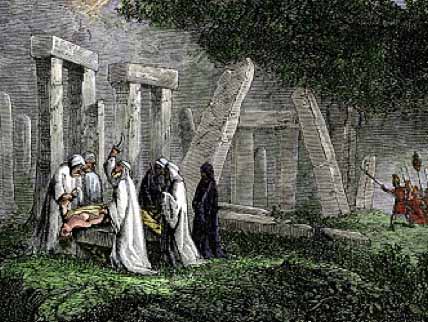Did Celtic Druids Practice Human Sacrifices ?

The Romans, conquerors of Gaul in the 1st century BC, endeavored to destroy there the influence of the druids, charismatic chiefs of the populations. Was it a political bias or rather a safeguard against a Gallic cult and religious leaders much less harmless than they say?
The cult of violence and the learning of murder
Gallic society is dominated by Druids and warriors, two groups that their function places at the center of the practices condemned by the Roman conquerors. But it would be simplistic to see in these warriors men sowing death around them, whereas the druids would only be bearded old men charged with cutting the mistletoe with golden sickles.
One of the Druids' missions is to teach warriors about murder and the use of force. This teaching is based on an initiation into death, which one must be able to give without fail but also to receive without weakness. The Druid religion teaches that each man has an immortal soul, which passes, upon death, into the body of another man. We must therefore not fear the stage which marks the end of a life, nor hesitate to anticipate it during fights in order to arouse the admiration of the adversary and to satisfy the gods with our own sacrifice.
To achieve this perfection in the culture of violence, young warriors are grouped by age and cut off from the adult world. They learn the techniques of hunting (deer or wild boar), as well as unarmed combat, and they maintain themselves through physical exercises in the best shape possible.
Sacrifices to the gods for every occasion
Perhaps, however, there is more. Caesar, in the Gallic War, underlines the barbarism of society, and gives as an example the existence of many human sacrifices. Several events give rise to these sacrifices, which take various forms depending on whether they are performed in honor of this or that god. The sacrifices intended to honor the gods each follow a specific ritual. Thus, when a victim is immolated in honor of Toutatis, the god of War and of the Peoples, he is drowned in a barrel filled with water. The god Esus, another very bloodthirsty war god, is honored by hanging. The victims that we dedicate to Taranis, god of Heaven and Thunder, are locked in a huge wicker or hay colossus which, placed on a pyre, is ignited by a druid. Volunteers, criminals or prisoners of war are sacrificed, but also sometimes, if there is no other choice, anyone.
A bloody divination
Going to war is another opportunity to celebrate such rites. This is the moment when a key figure in Gallic society intervenes, the diviner or priestess, responsible for sacrificing a victim (it is primarily a prisoner) before the fight in order to know the outcome. The official takes the victim up a ladder at the top of a huge cauldron, and stabs it, spurting its blood on the walls. The blood, while coagulating, leaves marks on the edges of the container that the soothsayer is responsible for interpreting. The color, the consistency, the direction of the bloody traces are all prophetic signs. When these signs are difficult to read, the priestess repeats the operation with another victim, and continues if the need arises. At the bottom of the cauldron, the blood of the various victims remains liquid and accumulates. When there is enough, the woman grabs a ladle and sprinkles the crowd of warriors present, fanaticized by the ceremony and ready to die in combat.
Archeology confirmations
Thanks to the discoveries made in the 1960s in Gournay-sur-Aronde (Oise), we can now describe the calendar of human sacrifices in a Belgian tribe, the Bellovaci, in whom these events are linked to the seasons and the major festivals. In Saintes, again in 150 AD, a sacrifice is made: 17 people die there. Among them are three children. The adults were killed by decapitation.
Caesar therefore did not lie. We sacrifice people to punish them but also to meet the requirements of the Gallic pantheon to which we must prove its strength and whose homicidal desire we must exalt. The emperors, from the beginning of the Roman presence in Gaul, proclaimed the suppression of the Druids and prohibited human sacrifices. However, this practice did not completely disappear until the 4th century.









































































































































































































































































































































